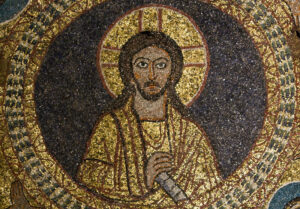“Any upheaval in the universe is terrifying because it so profoundly attacks one’s sense of one’s own reality. Well, the black man has functioned in the white man’s world as a fixed star, as an immovable pillar, and as he moves out of his place, heaven and earth are shaken to their foundations.”
Most stars die slow deaths. For the last few million years of their existence, they expand, becoming what’s known as a “red giant,” swallowing orbiting planets and moons; but this increase in size is a decrease in mass and energy. They are, essentially, burning themselves out. One by one, their outer layers are sloughed off into space, until all that’s left is a small, but dense, core: a ‘white dwarf,’ fizzling down to nothing.
Very rarely, though, a star refuses to die quietly: it simultaneously implodes and explodes. The explosion—a massive supernova—sends a shockwave of stellar material into the far reaches of space, destroying almost everything in its path. Meanwhile, the implosion—the star’s core collapsing in on itself—produces a black hole, invisible to most methods of detection, but exerting a powerful gravitational pull. Unlike a white dwarf, a black hole may even continue to grow; the more matter it is able to consume, the longer it will last, and new cosmic systems will coalesce in its orbit. Our own Milky Way galaxy revolves around one such supermassive black hole.
. . .
In the wake of George Floyd’s lynching at the hands of the Minneapolis Police Department, many white socialists are learning that what they believed to be a white dwarf, slowly burning itself out, was, in fact, a black hole. We are living in what Black studies scholar Saidiya Hartman has called “the afterlife of slavery.” “Black lives,” she writes, “are still imperiled and devalued by a racial calculus and a political arithmetic that were entrenched centuries ago.”
Like a supernova, slavery in the United States ostensibly ended in the brilliant and blinding flash of a civil war. But, also like a supernova, its corresponding implosion means that this world continues to revolve around the gravitational pull of its core structures. Instead of a general and peripheral ‘racism,’ which might wither and die as global capitalism adopts new ways to justify suffering and inequality, the afterlife of slavery is characterized by a globalized antiblackness. “I, too, live in the time of slavery,” Hartman writes elsewhere, “by which I mean I am living in the future created by it.”
This is a ‘difficult teaching’ for many socialists, because fully reckoning with its implications requires a Copernican shift in the way socialists understand the relationship between blackness and value. It means seeing slavery as more than a form of what Karl Marx called “primitive accumulation”—the violent expropriation marking the difference between those who possess property and those who do not. Instead, antiblackness is the gravitational anomaly around which ‘value’ revolves. The formal, but limited, freedom that sets the terms for capitalist exchange gains content only by creating a class of people who are chronically incapable of realizing that freedom. Black feminist theorist Hortense Spillers refers to this idea as the “twin fetish:” the “commodity fetish” pointed out by Marx works in tandem with a racial one.
The difficulty is only compounded for socialists invested in the ongoing relevance of Christianity for the struggle against global capital. The German Jewish philosopher Walter Benjamin once wrote that “capitalism has developed as a parasite of Christianity in the West … until it reached the point where Christianity’s history is essentially that of its parasite.” If he is right, however, then a primary vector of this parasitism was the invention of race.
This presents a problem with which any attempt at a specifically Christian form of socialism must grapple: Christianity, as a ‘political theology’ organizing society, is a white dwarf. Its ‘red giant’ moment began in 1492, when it violently expanded, consuming and obliterating many of its ‘others.’ It has not passed away, and its ejected materials are being put to new uses at every moment; but its former satellite is now its gravitational anchor.
. . .
Despite the complex relationship between Christianity and money, it is relatively easy to point towards evidence of conflict between Christian ethics and the accumulation of wealth. From the parable of the ‘rich young ruler’ to the medieval prohibition on usury, examples of the opposition of God and Mammon abound. It becomes much more difficult to separate the ‘good’ from the ‘bad’ in Christian history, however, when one takes the conjunction of blackness and value as one’s point of departure, rather than a criticism of greed and avarice. Christianity, after all, bore a critical role in the invention of racial difference. As literary theorist Gil Andijar has observed, Christianity’s most strident criticisms of financial accumulation have often been framed in terms of race—such that, as in the image of the ‘Jewish usurer,’ the difference between virtuous and vicious relationships to money is often couched in a difference between bloods.
The work of Jamaican philosopher Sylvia Wynter brings home the intractability of this problem. The passage from medieval to modern political order in the wake of Latin Christendom, she argues, was characterized, in part, by the passage from an understanding of common humanity organized around the capacity to become Christian, to one organized on the basis of the capacity to be political and, finally, to be economically rational. At each stage, it is the fact that some people are said to differ from this ‘common’ humanity that makes the very ‘commonness’ of humanity intelligible. One learns who is fully ‘human,’ in other words, only by learning who is not.
Racial difference is a Christian invention—something Wynter demonstrates most forcefully through the example of Bartolomé de Las Casas—but it is a Christian invention that quickly comes to set the terms for Christianity’s continued significance for the world. Like Sagittarius A*, the black hole at the center of our own galaxy, antiblackness is now a pivot around which both capitalism and Christianity turn.
. . .
Stars, planets, and other orbital bodies do not form apart from the gravitational systems in which they move. Very rarely, however, a ‘rogue body’ will be knocked from its orbit, falling into the orbit of a new star or black hole, or even orbiting its galaxy, directly. Christianity is essentially, not accidentally, determined by its former satellite. Whether or not Christianity can escape the ‘event horizon’ of antiblackness, becoming a ‘rogue star,’ is a question that can only be answered by Christians.
This answer can only come as a result of a practical reckoning with the fact of Christianity’s structural imbrication with antiblackness; it cannot be known in advance. Escape velocity may yet be an impossibility for Christianity, but it is incumbent upon Christian socialists to try and find out.
Sean Capener is a Toronto-based writer and PhD candidate. He is on Twitter @CapenerSean.



